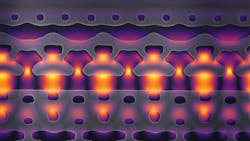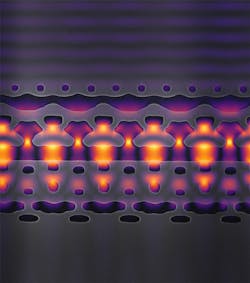Particle Accelerator Fits on a Chip
Stanford researchers built a particle accelerator that fits on a chip, miniaturizing a technology that can now find new applications in research and medicine.
On a hill overlooking Stanford University, the SLAC National Accelerator Laboratory operates a particle accelerator scientific instrument nearly two miles long. In this giant accelerator, a stream of electrons flows through a vacuum pipe while bursts of microwave radiation push the electrons faster and faster until their velocity approaches the speed of light. Now scientists at Stanford and SLAC have an accelerator that fits on a chip. It accelerates electrons using an infrared laser to deliver the energy “pushes”. But the boosts need to be applied quickly as there are only a few microns of distance to do it.
The chip, which is a prototype, was built by carving a nanoscale channel out of silicon, sealing it in a vacuum, and sending electrons through the channel while pulses of infrared light, to which silicon is transparent, were transmitted by the channel walls to speed the electrons along.
Getting the pulses of IR light to accelerate the electrons was difficult. The IR light had to be fired through silicon, hit an electron at just the right time and angle to get them moving faster.
To do this, the team turned the design process upside-down. In traditional accelerators, like the one at SLAC, engineers generally draw up a basic design, then run simulations to physically arrange the microwave bursts to deliver the greatest possible acceleration. But microwaves measure four inches from peak to trough, while infrared light has a wavelength of about 10 µm. That difference explains why infrared light can accelerate electrons in such short distances compared to microwaves. But it also means the chip’s physical features must be 100,000 times smaller than the copper structures in traditional accelerators. This demands a new approach to engineering based on silicon integrated photonics and lithography.
Vuckovic’s team solved the problem using inverse design algorithms that her lab has developed. These algorithms let researchers work backward by specifying how much light energy they wanted the chip to deliver, and then tasking the software with suggesting how to build the right nanoscale structures required to bring the photons into proper contact with the flow of electrons.
The design algorithm came up with a chip layout that includes a channel etched out of silicon. Electrons flowing through the channel run a gauntlet of silicon wires that poke through the canyon wall at strategic locations. Each time the laser pulses, which it does 100,000 times a second, a burst of photons hits a bunch of electrons, accelerating them forward. All of this occurs in less than 10 µm on the surface of a vacuum-sealed silicon chip.
The accelerator’s design can be scaled up to deliver particle beams going fast enough for experiments in chemistry, materials science, and biological discovery that don’t require the power of a miles-long accelerator.
“Again, it’s a matter of size. Today, medical X-ray machines fill a room and deliver a beam of radiation that’s tough to focus on tumors, requiring patients to wear lead shields to minimize collateral damage,” says Byer. “We begin to show how it might be possible to deliver electron beam radiation directly to a tumor, leaving healthy tissue unaffected.
The researchers want to accelerate electrons to 94% of the speed of light, or 1 million electron volts (1MeV), to create a particle flow powerful enough for research or medical purposes. This prototype chip provides only a single stage of acceleration. The electron flow would have to pass through around 1,000 of these stages to achieve 1MeV. But that’s not as daunting at it may seem, says Vuckovic, because this prototype accelerator-on-a-chip is a fully integrated circuit. That means all the critical functions needed to accelerate electrons are built into the chip, and increasing its capabilities should be reasonably straightforward.
The researchers plan to pack a thousand stages of acceleration into roughly an inch of chip space by the end of 2020 to reach their 1MeV target. Meanwhile, in anticipation of developing a 1MeV accelerator on a chip, electrical engineer Olav Solgaard is working on a possible cancer-fighting application. Today, highly energized electrons aren’t used for radiation therapy because they would burn the skin. Solgaard is working on a way to channel high-energy electrons from a chip-sized accelerator through a catheter-like vacuum tube that could be inserted below the skin, right alongside a tumor. This would let the beam administer radiation therapy surgically.
“We can derive medical benefits from the miniaturization of accelerator technology in addition to the research applications,” Solgaard said.

